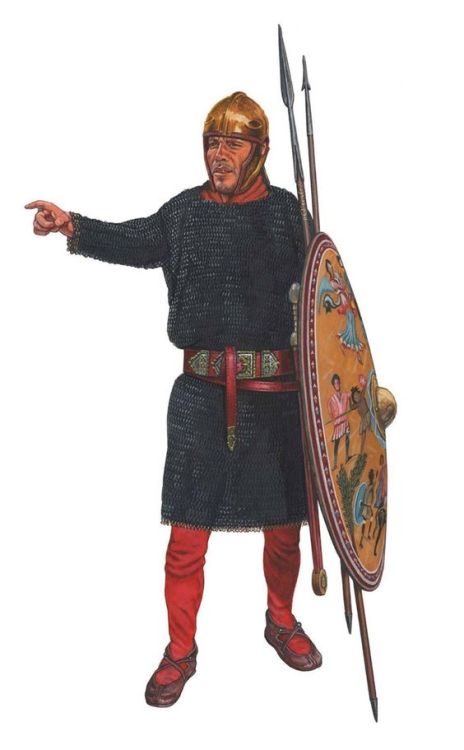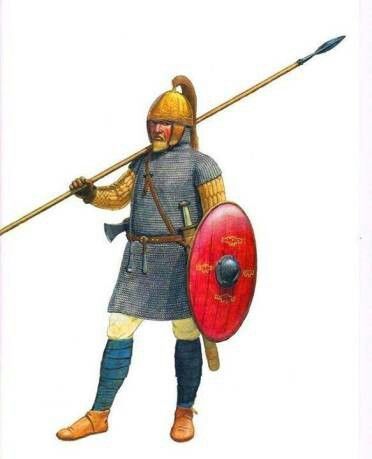The Evolution of the Roman Army Part VI — About that there Barbarisation TheoryIn case you mis
The Evolution of the Roman Army Part VI — About that there Barbarisation TheoryIn case you missed — Part I, Part II, Part III, Part IV, Part VIt’s at this point in the series where I feel I need to address a common misconception about the barbarians of the late Roman Empire. In the next few posts, we’re going to get into the 5th century and eventually end with the fall of the Western Roman Empire. As an aside, I once again want to express that if anyone wants to pick up where I left off by doing a series on the “Evolution of the Byzantine Army”, please let me know, if it is good stuff, I will reblog it on the spot.The Barbarisation Theory is basically the idea that recruitment of barbarians into the ranks of the Roman Army decreased it’s effectiveness so that it could no longer defend the empire. Essentially, the barbarians joined the Roman Army making it barbarized to the point that it did away with good old fashioned Roman discipline and tactics and became a collection of mob-like bands of barbarian mercenaries. This theory was first developed by Edward Gibbons in the 18th century with his work “The Fall of the Roman Empire”, made popular in the 19th century, but today is widely discredited among historians. Regardless, the common media trope of the barbarians sacking Rome usually involve half naked ruffians wearing animal skins, war paint, and wildly charging at the Romans in their numerous hordes whilst yelling “RAWWWRRRR!!!!” This trope is more a result of 19th century romantic artistic depictions of barbarians, rather than real history.It is true that in the 4th and 5th centuries the Roman Army saw a large influx of barbarian recruits. By around 390 AD it is estimated that around 25% of the Western Roman Army were foreigners, with the Eastern Roman Army comprised of 33%. For the west these percentages would increase even more as the 5th century progressed. However, the large influx of foreign recruits in the army did not “barbarise” it, neither did the increased reliance on foederati and mercenaries. Rather the opposite is true; the Roman Army “Romanized” the barbarians. The Roman historian and former soldier Ammianus Marcellinus in his work “Res Gestae” makes it clear that barbarian recruits were held to the same standards of discipline and organization as any other Roman soldier. It was also not uncommon for foederati to receive similar military training, or at least have shared knowledge from comrades who had been recently discharged from the army. By the 4th and 5th century many barbarians peoples such as the Goths, Burgundians, Gepids, and the Vandals had been in contact with the Roman Empire for generations. Especially the Goths, who first show up on the scene in the mid to late 2nd century, way back during the reign of Marcus Aurelius. By the 5th century most barbarian tribes, who by then had multiple generations of men who had served in the Roman Army, had adopted Roman weapons, armor, organization, training, and tactics. This could be a very bad thing, as the barbarians who are proclaiming their loyalty to the empire today, could be sacking Rome tomorrow. One of the reasons why armies of the Late Republic and early empire were able to so easily defeat Celtic and Germanic armies was often because of their superior organization, discipline, professionalism, and tactics. This was the reason why Julius Caesar was able to defeat Gaulic armies that outnumbered his by 4:1 on several occasions. However, now the Roman way of warfare was no longer exclusively the Roman way of warfare, it had become the way everybody fought, no matter what empire, kingdom, or tribe. It should be noted that the shield wall tactics created by the Late Roman Army would become the tactics of later successful armies well into the Middle Ages, such as that of the Franks, the Anglo-Saxons, the Vikings, and the Normans. Rather than being hordes of rampaging barbarians, the barbarians fielded well disciplined, well organized, and well equipped professional armies. The Romans no longer had the tactical edge they had maintained in the 1st and 2nd centuries. The Romans hadn’t necessarily gotten worse at warfare, but the barbarians were getting much better at it. With the empire crumbling economically, socially, and politically, the Romans were rapidly losing their strategic edge as well.Here’s a little game to drive home my point. The artwork in the pictures at the very top are either depictions of 5th century barbarian warriors, or 5th century Roman soldiers. Which ones are the barbarians, and which ones are the Romans?Top Left: FrankBottom Left: RomanTop Center: RomanBottom Center: GothTop Right: VandalBottom Right: Goth -- source link
#history#ancient history#military history#ancient rome#roman army#roman empire#barbarians





